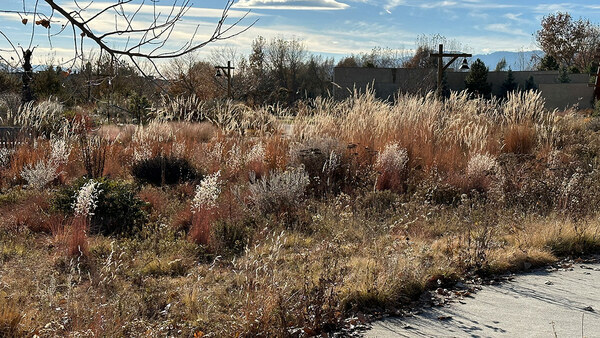
Ornamental grasses are a great addition to any type of garden. They can add an amazing amount of structure and layering that no garden should be without. They are also a beautiful foil to perennials and evergreen plants. Their foliage will often last all season long and sometimes well into the winter, depending on your personal gardening style and level of tidiness. Here are a few of my favorite grasses.

‘Karl Foerster’ feather reed grass (Calamagrostis × acutiflora ‘Karl Foerster’, Zones 5–9) is a very beautiful and tall warm-weather grass. It makes a great addition to a mixed border. It can also be used as a seasonal visual block or planted en masse. Since this is a prairie grass, it likes occasional deep summer watering that mimics summer rain showers. ‘Karl Foerster’ starts the season as a neat clump, and in early summer the panicles start to take off. They quickly rise 3 to 4 feet tall. I’ve seen some that are taller, but I suspect that they were overfertilized and would quickly flop over. The tall panicles are tough but will move and sway in the gentlest of breezes. Some gardeners are quick to remove the panicles, which are, in fact, the best attribute of this grass. Don’t be tempted to remove them, as they do not self-seed. Make sure to keep the soil lean for two reasons: controlling overvigorous growth with the potential to flop and slowing the need to divide as the center dies out, since this is a clump grower. It will grow between 20 and 24 inches wide and 4 to 5 feet tall. Late winter cleanup is best before new growth starts and will help keep this grass neat and attractive.

‘Aureola’ Japanese forest grass (Hakonechloa macra ‘Aureola’, Zones 5–9) is quite the mainstay in many Northwest gardens. It has bright chartreuse green foliage with a dark strip that creates a unique low-mounding effect and billows in the wind (like all my favorite grasses!). ‘Aureola’ has so many great uses. It can be used to create a quintessential Asian-inspired garden, added to a mixed border with high contrast purples and dark green plants, or planted in containers alongside spring bulbs such as tulips (Tulipa spp. and cvs., Zones 3–8), daffodils (Narcissus spp. and cvs., Zones 3–9), and late-season lilies (Lilium spp. and cvs., Zones 3–10) for an amazing effect. I have some planted as a ground cover under yellow twig dogwoods (Cornus sericea ‘Flaverimea’, Zones 3–8) and columnar yews (Taxus baccata ‘Erectus’, Zones 6–7) in a shady north-facing garden that looks great almost year-round. This grass hails from the mountainous regions of Japan and is equally comfortable in shady gardens, morning sun areas, and full sun with consistent moisture. The bright golden foliage will bleach out in hotter, sunnier areas. In the fall, the grass blades turn a lovely buff straw color. I often leave all the foliage until late winter when the old blades will just pull out of the ground. For a tidier look, you can cut the old blades to the ground when they finally start to look terrible! ‘Aureola’ is a stoloniferous grass, which means it will slowly spread and colonize the area in which it was planted. However, it’s easy to remove and transplant or give to your gardening friends. It will grow 3 feet tall and 3 feet wide or larger as the clumps mature.

Undaunted® ruby muhly grass (Muhlenbergia reverchonii ‘PUND01S’, Zones 5–9) is a stunning late-season clumping grass that is equally suited to regularly watered or infrequently watered areas. Ruby muhly grass starts to push out its ruby pink–colored panicles in midsummer, considerably earlier than pink muhly grass (Muhlenbergia capillaris, Zones 6–10). It is also much hardier than pink muhly grass, which is often unreliably hardy in the Northwest. Its smaller form is great for in-city gardens and hellstrips. The pale green to gray thin, wiry foliage looks great all season long and lasts well into winter. This will be its third year in my hellstrip and it is performing well, even after a heavy late-season snow. It is native to North Texas and Oklahoma, so it is used to tough conditions, lean soils, and low nutrients. As with all warm-weather grasses, it is best to clean up the old foliage in late winter or early spring before the new growth starts. It will grow 2 to 3 feet wide and about as tall; however, it will be smaller and less vigorous with less water.
I hope my recommendations have inspired you to try some stalwart grasses as newcomers to your garden. Happy gardening!
Jason Jorgensen is a landscape designer in Seattle, Washington.


















Comments
Log in or create an account to post a comment.
Sign up Log in